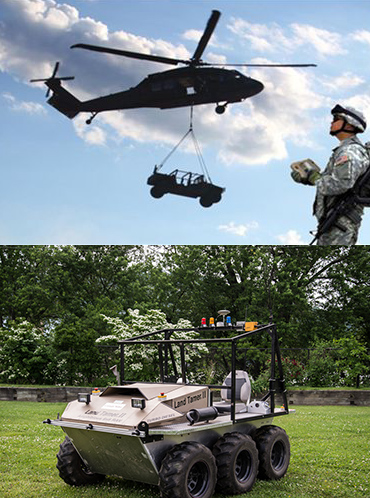Carnegie Mellon’s NREC and Sikorsky Aircraft Will Pair Unmanned Ground Vehicle with Autonomous Helicopter Robot Team Will Autonomously Survey Sites for Radiation, Biological or Chemical Contamination
Byron Spice Tuesday, June 3, 2014Print this page.

PITTSBURGH—Carnegie Mellon University’s National Robotics Engineering Center (NREC) and Sikorsky Aircraft Corp. are working with the U.S. Army Tank Automotive Research, Development and Engineering Center (TARDEC) to show that an autonomous helicopter and an unmanned ground vehicle can work together to autonomously survey a contaminated site.
In a demonstration at the culmination of the 18-month project, a Black Hawk helicopter will carry the unmanned ground vehicle (UGV) in a sling, deliver it to a remote site and return to base. The UGV will then traverse the rugged site, using its on-board sensors to survey for chemical, biological, radiological or nuclear contamination. All of this will occur out of direct sight, without human intervention and without putting human lives at risk.
The Extended Operational Reach with Autonomous Air and Ground Vehicles project will be led by NREC and is sponsored by TARDEC through the Robotics Technology Consortium.
“This is an exciting new opportunity for an unmanned aerial vehicle and UGV to autonomously work together to accomplish a mission which is only possible as a team,” said Jeremy Searock, program manager for NREC. “Our autonomous vehicle team will provide the Army with the capability to collect information on the ground while keeping soldiers hundreds of miles away. As a former military officer, I am always proud to provide new capabilities to keep soldiers safe.”
NREC will modify a Land Tamer all-terrain vehicle with an autonomous driving system that uses key elements from previous projects that have supported unmanned on-road and off-road exploration, including NREC’s Crusher off-road vehicle and the Boss SUV that was CMU’s winning entry in the 2007 Urban Challenge road race. The autonomous Land Tamer will feature sensing that will let it operate day and night under all visibility conditions.
Sikorsky will modify a Black Hawk helicopter that can fly at speeds greater than 138 mph with an 8,000-pound load slung beneath it. It uses Sikorsky’s autonomous mission manager and supports nap-of-the-earth flight with autonomous take-off and landing, obstacle avoidance and landing zone identification. Sikorsky recently used the same aircraft in cooperation with the U.S. Army to demonstrate the capability to autonomously deliver supplies to soldiers in the field.
“Sikorsky is aggressively investing in and developing its autonomy applications with an eye toward the future products that will carry this technology and the capabilities they deliver,” said Mark Miller, the company’s vice president of research and engineering.
The project’s culminating demonstration will take place in September 2015 at Sikorsky’s test site in Florida. The helicopter will carry the Land Tamer in a sling, autonomously find a good landing spot, lower the vehicle to the ground and release it. The ground vehicle will then autonomously explore the site, taking readings with its on-board sensors, while crossing rugged terrain and dealing with an unpredictable environment.
NREC performs advanced research and development and early prototype development for governmental and industrial clients. It is part of Carnegie Mellon’s acclaimed Robotics Institute and the top-ranked School of Computer Science, which is celebrating its 25th year. Follow the school on Twitter @SCSatCMU.
Byron Spice | 412-268-9068 | bspice@cs.cmu.edu
